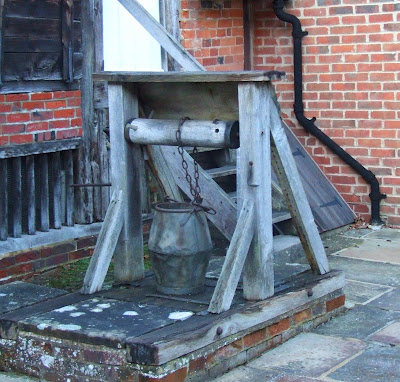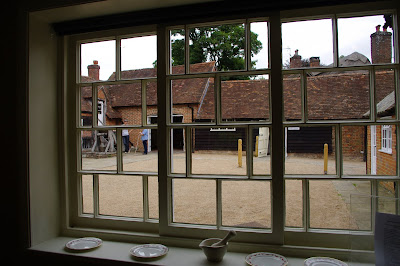
South Downs at Selborne Near Chawton
Water is integral to our very existence. Our bodies need water to stay alive. We need water to grow food. We cook mostly with water. Water can create energy and we need it for hygiene and for cleaning.
Oil, that creator of controversial issues, is running out. We need to cut down on carbon emissions because our climate is being irreparably damaged and water is going to be, is becoming, the most valuable commodity on our planet. Wars will be fought over it.
Here in Europe, as far as water goes, the Northern part of Europe is rich in water supplies. Climate change may well give us too much water. However, Southern Europe, the Mediterranean regions of Italy, Southern France, Spain, Greece and the North African countries are becoming more and more desertified. This means populations will want to migrate north to where the water is. This will cause pressures on populations and maybe even wars, civil wars, as people fight for land and water.
In 1809, Jane, with her mother, Cassandra and Martha Lloyd moved to Chawton. Claire Tomalin in her biography of Jane tells us that Edward, Jane’s brother, who was the owner of The Great House and many properties and much land in the area, had the cottage renovated and improved for his sisters and mother.

The well at Chawton Cottage
“ Before the ladies arrived, Edward had the plumbing renewed for them. This did not mean indoor sanitation, of course; some town houses had water closets by then – Henry’s and Eliza’s perhaps – but you did not expect the luxury of piped water in a country cottage. An improved pump at the back, and a better cess pit for the privy, well away from the house would be enough.”And, a new well was dug in the backyard.
How was water used in the cottage at Chawton by Jane and her family?

Kitchen hearth and table at Chawton Cottage
In the backyard you can see the well with the bucket winched up to the top. It is a large zinc bucket which would have held a large quantity of water.It would have taken some strength to wind it up from the depths of the well and then be carried to the kitchen for it’s various uses.
How did the water get to the bottom of the well and what would it have been like?
Chawton is situated in mid Hampshire amongst the South Downs which consist of chalk. It is just north of the clay beds and gravel deposits of the southern part of Hampshire. Rainwater running off the ground, into streams and rivers and water seeping into the stratas of chalk, clay and gravel, which underlie the landscape of Hampshire, absorb the minerals from the ground it permeates. In Hampshire we say we have hard water. This is because a lot of chalk and other minerals are dissolved into it. This is not a bad thing and it could be argued that certain minerals are good for our bodies but it makes the water difficult to use. Cooking with it creates a lot of lime scale on utensils, which need to be cleaned, with difficulty. Lime scale is a hard calcareous deposit and can be almost like concrete. I know, I have to clean my electric kettle out every now and then.

Another view of the kitchen

View of the stable yard from the kitchen window at Chawton
Jane lived in a hard water area and so had to contend with the difficulties of hard water. Next week I will continue in this vein and discuss washing and personal hygiene.
Posted by Tony Grant, London Calling

6 comments:
Tony, your explanation of why water was hard in and around Chawton makes so much sense. I cannot imagine what it was like to haul one's water for everything, including cleaning the dishes, doing laundry, washing oneself, and scrubbing floors and cooking.
Water was not drunk as a matter of course, for it (especially in cities) spread diseases. People tended to drink watered down ale or wine, or boil their water making tea, hot chocolate, and coffee.
Thanks, Vic.
I hope I haven't just started a public health scare. The water we get through taps at my home is perfectly clean and drinkable. It is drawn from rivers and underground aquafers and goes through a purification process to kill and remove all harmful bacteria.
Here is a quote from Southern Water, the company that provides me and my family with water.
"Your drinking water:
We supply top quality drinking water to more than one million households every day.
About 70% of water supplies in our region are taken from underground sources (groundwater*) predominately chalk* but also greensand* sources. The remainder comes from rivers and storage reservoirs.
The majority of water we supply is hard as it comes from the chalk but the hardness varies from source to source.
Hard water can lead to the formation of limescale in water systems and household appliances that can be avoided by using water softeners.
The quality of the drinking water we supply is very high. A comprehensive testing and monitoring programme is in place throughout the treatment and supply processes. This is all audited by the Drinking Water Inspectorate* and each year we produce a report on our water quality.
On these pages you can learn more about your drinking water including the role water can play in your health.
Looking after water in your home.*
Here is a link if you are interested:
http://www.southernwater.co.uk/homeAndLeisure/drinkingWater/default.asp
Thank you. Honestly, I have always been curious about the water supply during this time - its source, use, etc. Today water is a staple in our lives; much more so than I remember as a child. Nowadays, everyone is walking around with a bottle of it as if an appendage!!!
I've often wondered about personal hygiene using water. What did one use to brush one's teeth?? Deodorant? Bathing? Toilets?
Loved reading this. Looking forward to more!
~Kolein
New York
I would imagine that the research that went into this post was extensive. Great job.
I love Jane Austen and everything related to her life and writing. Thank you for this wonderful blog. I am now your follower.
Have a nice day!
Great job indeed. I was so stunned to the entire picture that you post in this blog. I love the all picture so much. Thank you for sharing it.
Post a Comment